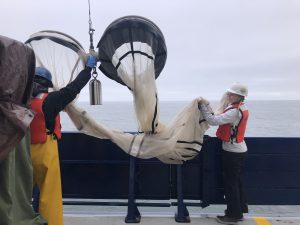Biological Oceanographers come equipped with an arsenal of nets at their disposal, with some as simple as a ring net and others like the MOCNESS (Multiple Opening and Closing Net Environmental Sensing System) loaded down sensors and moving parts. Regardless of complexity, each net contains essential core parts including a frame, a mesh and a cod end.
The frame holds the net, which is comprised of a conical mesh with varying size holes. Typically for our plankton sampling we use a 202 um mesh, which is dictated by the particular group of organisms we want to catch. Finally, the cod end is a cylindrical plastic bucket secured to the narrow end of the net by a plastic collar. The cod end collects all the plankton, filtering water out mesh holes (also 202um) in its side as the net is dragged through the water.
One of our key nets this cruise is the Bongo Net, which imitates its namesake with a side-by-side two net system. Bongos can be towed through the water obliquely or vertically, but for the CCE cruise protocol we conduct oblique tows twice per day. The day-night pairing is useful to compare since plankton undergo diel vertical migration, the process of moving shallow at night to feed and descending to depth to hide during the day.

The process of deploying the Bongo involves teamwork and communication between scientists and the res tech. First, the cod ends are secured to the two collars at the ends of the long mesh nets. Next, the Bongo and a weight are connected to a winch and gradually lowered down off the side of the ship at a desired “pay out” speed from the winch. Once the winch has paid out 300m of wire, the net is held at depth for 30 seconds before hauling in. Throughout this process we are recording the angles of the winch at certain depths to ensure proper tension on the wire, keeping time and signaling or shouting to the winch operator and res tech who runs the operation.

Once the Bongo has surfaced, we spring into action to secure our samples. We quickly but thoroughly rinse down the net so that plankton stuck to its side end up in our cod end. The port side net is used for a range of analyses that demand that the animals stay alive so we must act swiftly. The animals are anesthetized with soda water (unflavoured) and the sample is divided up, processed into size classes and frozen in liquid nitrogen for measurements of weight and diet back on shore. The starboard net is strained entirely in a glass jar with a formalin (or formaldehyde) solution, which preserves the shape and features of the organisms. Repeating this process at least once per day has allowed us to tune the rhythm of our operation to the beat of the bongo.


